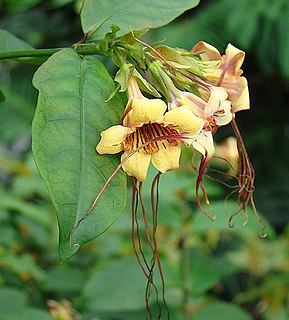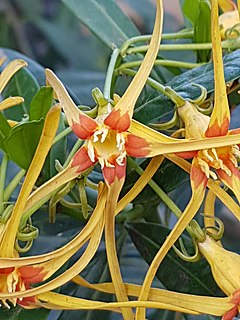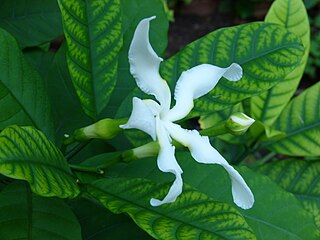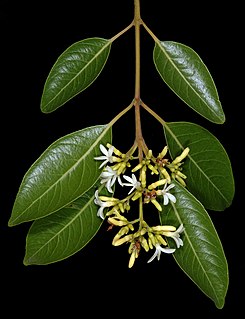
Rosa multiflora is a species of rose known commonly as multiflora rose, baby rose, Japanese rose, many-flowered rose, seven-sisters rose, Eijitsu rose and rambler rose. It is native to eastern Asia, in China, Japan and Korea. It should not be confused with Rosa rugosa, which is also known as "Japanese rose", or with polyantha roses which are garden cultivars derived from hybrids of R. multiflora. It was introduced to North America, where it is regarded as an invasive species.

Senna alata is an important medicinal tree, as well as an ornamental flowering plant in the subfamily Caesalpinioideae. It also known as emperor's candlesticks, candle bush, candelabra bush, Christmas candles, empress candle plant, ringworm shrub, or candletree. A remarkable species of Senna, it was sometimes separated in its own genus, Herpetica.

Mentzelia multiflora, commonly known as Adonis blazingstar, Adonis stickleaf, desert blazingstar, prairie stickleaf and manyflowered mentzelia is a herbaceous perennial wildflower of the family Loasaceae.

Strophanthus preussii, the Preuss' strophanthus, is a plant in the dogbane family Apocynaceae.

Strophanthus sarmentosus grows as either a deciduous shrub or as a liana up to 40 metres (130 ft) long, with a stem diameter up to 15 centimetres (6 in). Its fragrant flowers feature a white to purple corolla, red or purple-streaked on the inside. Strophanthus sarmentosus is native from west and central tropical Africa to Uganda and Angola. Vernacular names for the plant include spider tresses and poison arrow vine. Its habitat is forested areas from sea level to 1,400 metres (4,600 ft) altitude.

Strophanthus speciosus, commonly known as the forest poison rope, is a tree, shrub or woody climber which is native to southern Africa.
Strophanthus welwitschii grows as a deciduous shrub or small tree up to 5 metres (16 ft) tall, or as a liana up to 8 metres (26 ft) long, with a stem diameter up to 10 centimetres (4 in). Its fragrant flowers feature a white turning purple corolla, creamy and red or purple-streaked on the inside. Its habitat is forests or rocky woodlands from 300 metres (1,000 ft) to 1,800 metres (6,000 ft) altitude. S. welwitschii is used in local medicinal treatments for respiratory conditions, gonorrhoea and scabies. The plant has been used as arrow poison. Strophanthus welwitschii is native to Democratic Republic of Congo, Tanzania, Angola and Zambia.

Strophanthus eminii is a species of flowering plant in the Apocynaceae family. It is referred to by the common name Emin's strophanthus, and grows as a liana up to 10 metres (33 ft) long or as a shrub or small tree up to 7 metres (23 ft) tall, with a stem diameter up to 6 centimetres (2.4 in). Its fragrant flowers feature a pink with white turning red corolla tube, white turning yellow with red spots and streaks inside. Vernacular names for the plant include "spider tresses" and "poison arrow vine". Its habitat is deciduous woodland or rocky bushland, from 600 metres (2,000 ft) to 1,650 metres (5,400 ft) altitude. Strophanthus eminii is used in local medicinal treatments for snakebites, skin diseases and wounds and also as an anthelmintic. The plant has been used as arrow poison. It is native to Democratic Republic of Congo, Tanzania and Zambia.
Hunteria umbellata grows as either a shrub or small tree up to 22 metres (72 ft) tall, with a trunk diameter of up to 40 centimetres (16 in). Its flowers feature a white, creamy or pale yellow corolla. The fruit is yellow and smooth. Its habitat is forests from sea level to 600 metres (2,000 ft) altitude. Its numerous local medicinal uses include for fever, leprosy sores, stomach and liver problems and as an anthelmintic, especially against internal worms. Hunteria umbellata has been used as arrow poison. The plant's hard wood is used in carving and to make small tools. The species is native to an area of tropical Africa from Guinea-Bissau in the west to Angola in the south.
Hunteria zeylanica grows as either an evergreen shrub or as a tree up to 15 metres (49 ft) tall, with a trunk diameter of up to 34.5 centimetres (13.6 in). Its flowers feature a white corolla. The berries are yellow. Its habitat is forests from sea level to 350 metres (1,150 ft) altitude. The trees can withstand salinity. Local medicinal uses include for stomach-ache. Hunteria zeylanica wood is used for weapon handles and as firewood. In Africa, the plant is native to Kenya and Tanzania and in Asia it is native to China, India, Sri Lanka, Indochina and western Malesia.

Ochrosia oppositifolia grows as a small to medium-sized tree up to 25 metres (82 ft) tall, with a trunk diameter of up to 50 centimetres (20 in). Its flowers feature a creamy to white corolla. Its habitat is coastal forest, bush or open areas to 100 metres (330 ft) altitude, rarely inland. Local medicinal uses include as a carminative and in high doses as an abortifacient. Ochrosia oppositifolia is native to regions from the Seychelles through tropical Asia to the Pacific.
Tabernaemontana coffeoides is a species of flowering plant in the Apocynaceae family. It grows as a shrub or small tree up to 10 metres (33 ft) tall, with a trunk diameter of up to 20 centimetres (8 in). Its fragrant flowers feature white corolla lobes. Its habitat is on dunes or on rocks in dry forest, bush or savanna from sea level to 1,300 metres (4,300 ft) altitude. Local medicinal uses include for weight loss and to combat fatigue. Tabernaemontana coffeoides is native to Seychelles, the Comoros and Madagascar. It is also rich in pharmacologically interesting indole alkaloids.

Tabernaemontana pachysiphon grows as a shrub or small tree up to 15 metres (50 ft) tall, with a trunk diameter of up to 40 centimetres (16 in). Its fragrant flowers feature white to pale yellow corolla lobes. The fruit is green, almost spherical, up to 15 centimetres (6 in) in diameter. Its habitat is forests from sea level to 2,200 metres (7,200 ft) altitude. Its numerous local medicinal uses include as a styptic, and as a treatment for headache, hypertension and to relieve cramps. The species is native to tropical Africa.

Alafia is a genus of lianas or climbing shrubs found in tropical Africa and Madagascar. The World Checklist of Selected Plant Families recognises 26 species:
Alafia barteri is a plant in the family Apocynaceae.
Alafia landolphioides grows as a liana up to 20 metres (66 ft) long, with a stem diameter of up to 2.5 centimetres (1 in). Its fragrant flowers feature a white corolla, dark red at the throat. The fruit is dark brown with paired cylindrical follicles, each up to 45 centimetres (18 in) in diameter.
Alafia lucida is a plant in the family Apocynaceae.
Baissea multiflora is a plant in the family Apocynaceae.

Diplorhynchus is a monotypic genus of plant in the family Apocynaceae native to tropical and southern Africa. As of August 2020, Plants of the World Online recognises the single species Diplorhynchus condylocarpon.
Petchia madagascariensis is a plant in the family Apocynaceae.










